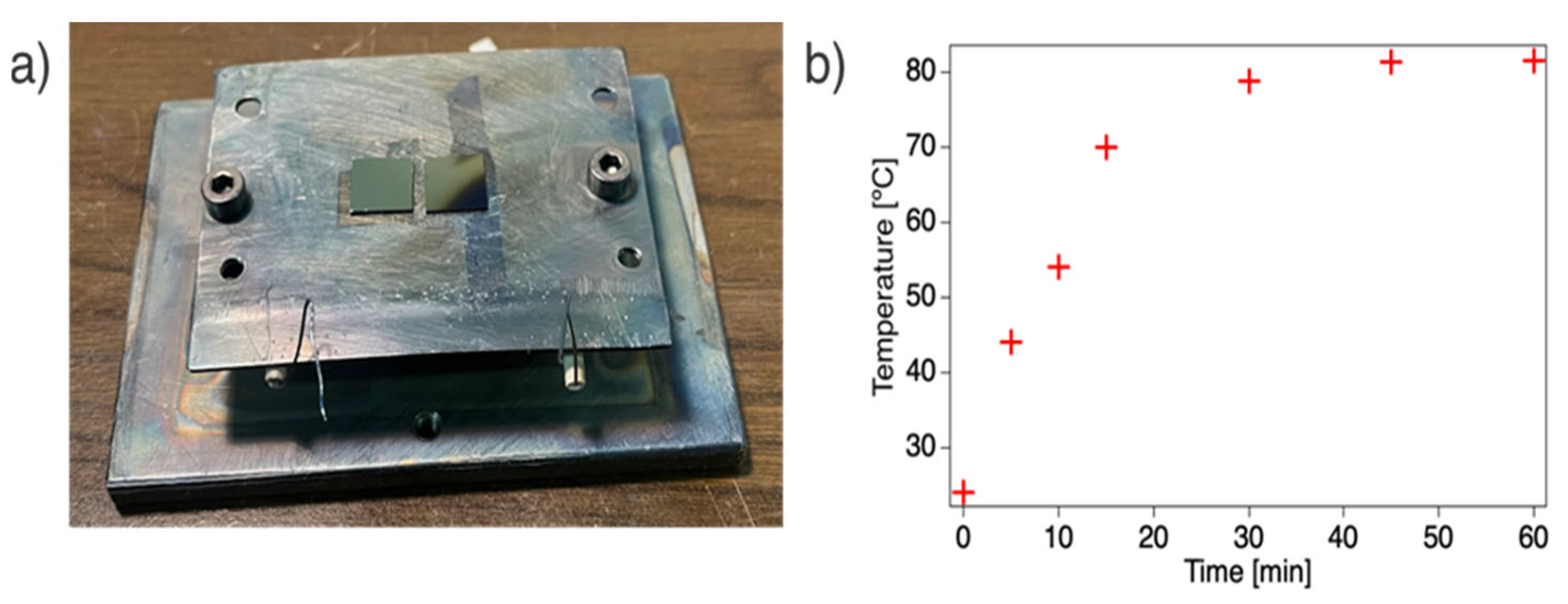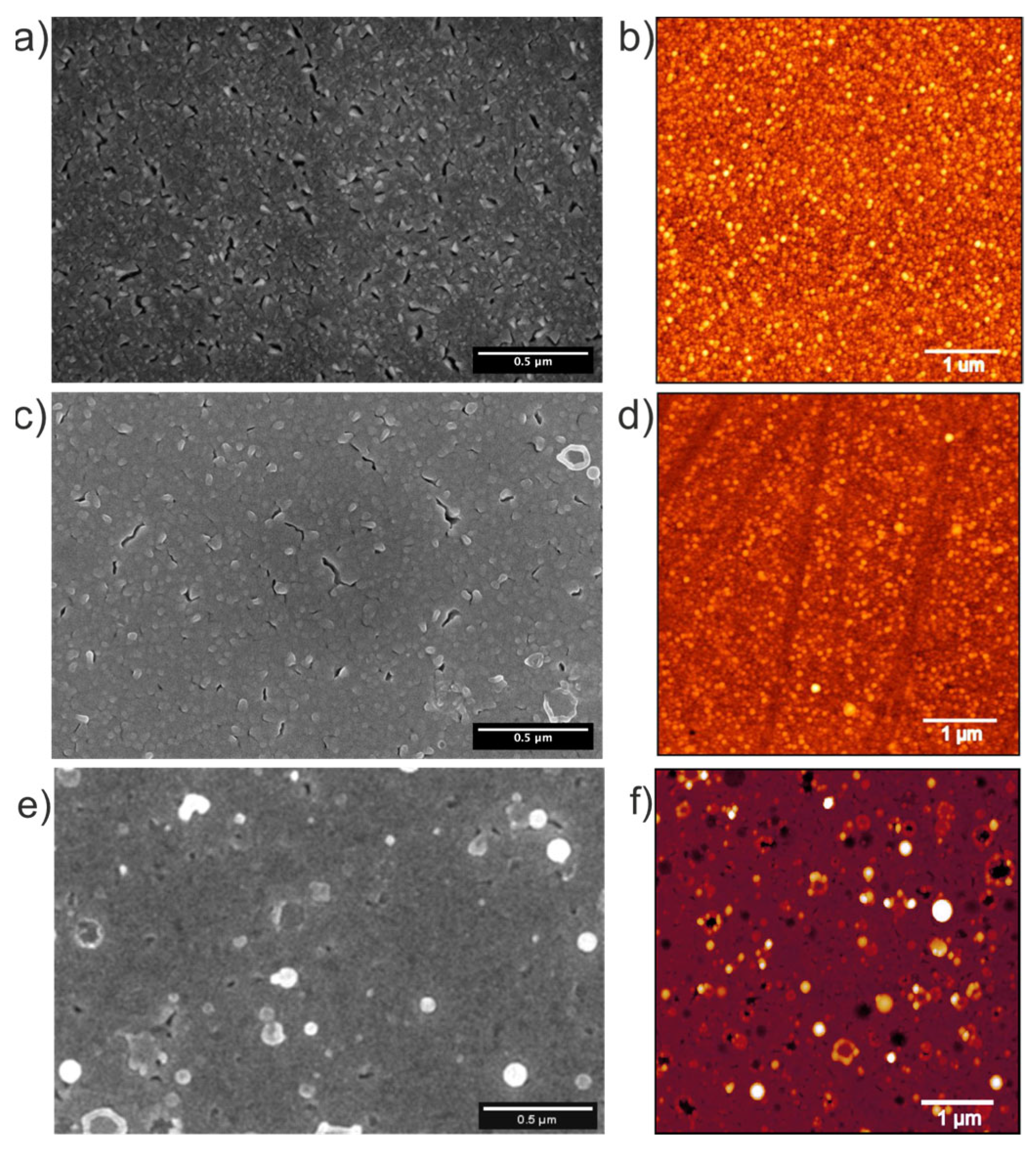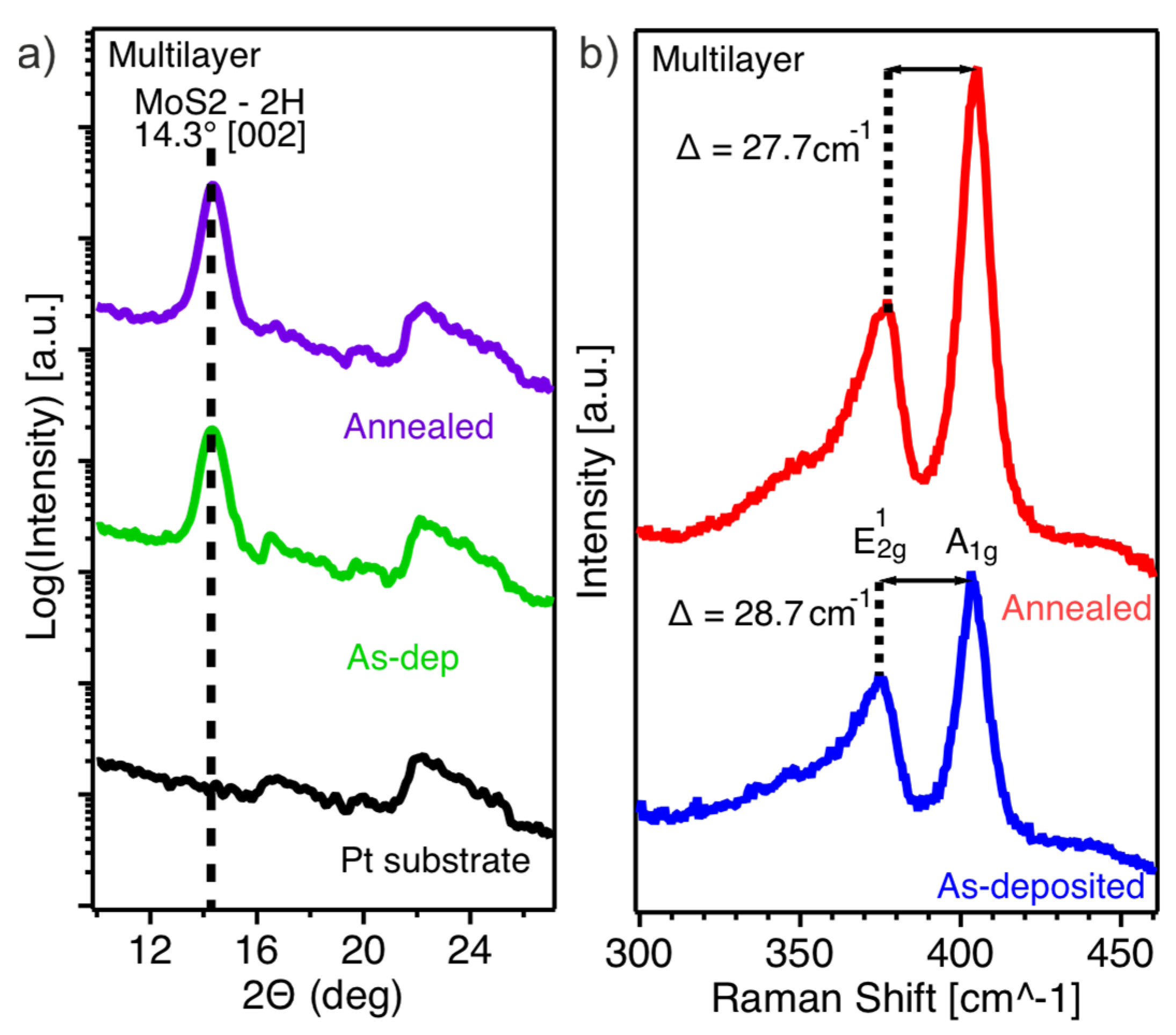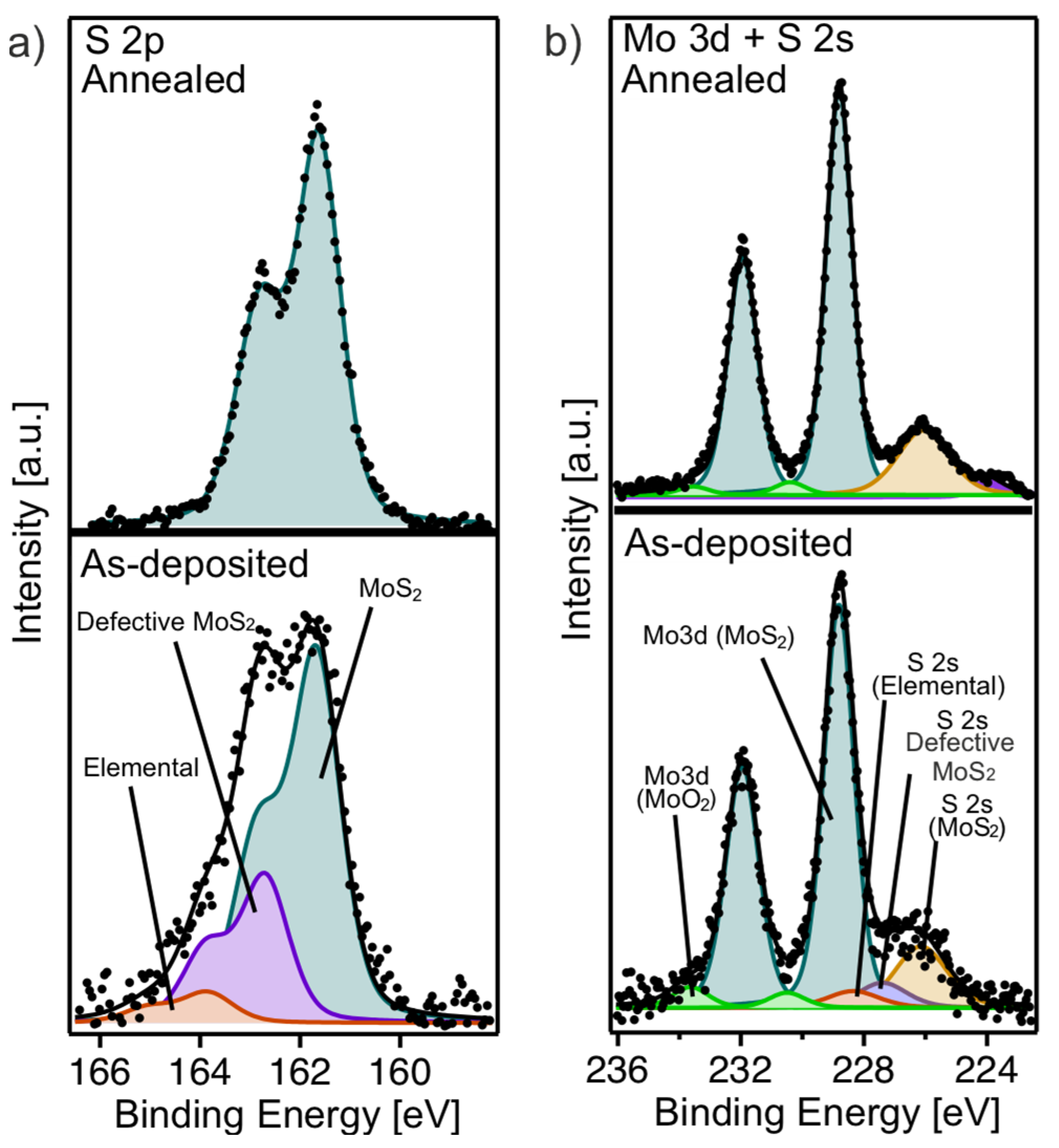Optimizing Crystalline MoS2 Growth on Technologically Relevant Platinum Substrates Using Ionized Jet Deposition: Interface Interactions and Structural Insights
Abstract
1. Introduction
2. Materials and Methods
2.1. IJD System Upgrade
2.2. Thin Film Growth
2.3. Structural and Morphological Characterization
2.4. Chemical Characterization
3. Results
3.1. Multilayer Film
3.2. Interface Film
4. Discussion
5. Conclusions
Supplementary Materials
Author Contributions
Funding
Institutional Review Board Statement
Informed Consent Statement
Data Availability Statement
Acknowledgments
Conflicts of Interest
References
- Bernardi, M.; Ataca, C.; Palummo, M.; Grossman, J.C. Optical and Electronic Properties of Two-Dimensional Layered Materials. Nanophotonics 2015, 6, 479–493. [Google Scholar] [CrossRef]
- Ye, M.; Winslow, D.; Zhang, D.; Pandey, R.; Yap, Y.K. Recent advancement on the optical properties of two-dimensional molybdenum disulfide (MoS2) thin films. Photonics 2015, 2, 288–307. [Google Scholar] [CrossRef]
- Kowalczyk, D.A.; Rogala, M.; Szałowski, K.; Kozłowski, W.; Lutsyk, I.; Piskorski, M.; Krukowski, P.; Dąbrowski, P.; Belić, D.; Cichomski, M.; et al. Local electronic structure of stable monolayers of α-MoO3−x grown on graphite substrate. 2D Mater. 2020, 8, 025005. [Google Scholar] [CrossRef]
- Samadi, M.; Sarikhani, N.; Zirak, M.; Zhang, H.; Zhang, H.L.; Moshfegh, A.Z. Group 6 transition metal dichalcogenide nanomaterials: Synthesis, applications and future perspectives. Nanoscale Horiz. 2018, 3, 90–204. [Google Scholar] [CrossRef] [PubMed]
- Xi, X.; Wang, Z.; Zhao, W.; Park, J.H.; Law, K.T.; Berger, H.; Forró, L.; Shan, J.; Mak, K.F. Ising pairing in superconducting NbSe2 atomic layers. Nat. Phys. 2016, 12, 139–143. [Google Scholar] [CrossRef]
- Bussolotti, F.; Chai, J.; Yang, M.; Kawai, H.; Zhang, Z.; Wang, S.; Wong, S.L.; Manzano, C.; Huang, Y.; Chi, D.; et al. Electronic properties of atomically thin MoS2 layers grown by physical vapour deposition: Band structure and energy level alignment at layer/substrate interfaces. RSC Adv. 2018, 8, 7744–7752. [Google Scholar] [CrossRef] [PubMed]
- Karmakar, S.; Biswas, S.; Kumbhakar, P. A comparison of temperature dependent photoluminescence and photo-catalytic properties of different MoS2 nanostructures. Appl. Surf. Sci. 2018, 455, 379–391. [Google Scholar] [CrossRef]
- Palencia-Ruiz, S.; Uzio, D.; Legens, C.; Laurenti, D.; Afanasiev, P. Stability and catalytic properties of 1T-MoS2 obtained via solvothermal synthesis. Appl. Catal. A Gen. 2021, 626, 118355. [Google Scholar] [CrossRef]
- Jiao, Y.; Hafez, A.M.; Cao, D.; Mukhopadhyay, A.; Ma, Y.; Zhu, H. Metallic MoS2 for High Performance Energy Storage and Energy Conversion. Small 2018, 14, 1800640. [Google Scholar] [CrossRef] [PubMed]
- Mahlouji, R.; Verheijen, M.A.; Zhang, Y.; Hofmann, J.P.; Kessels, W.M.; Bol, A.A. Thickness and Morphology Dependent Electrical Properties of ALD-Synthesized MoS2 FETs. Adv. Electron. Mater. 2022, 8, 2100781. [Google Scholar] [CrossRef]
- Surucu, O.; Isik, M.; Gasanly, N.M.; Terlemezoglu, M.; Parlak, M. Temperature-tuned band gap properties of MoS2 thin films. Mater. Lett. 2020, 275, 128080. [Google Scholar] [CrossRef]
- Liao, L.; Kovalska, E.; Regner, J.; Song, Q.; Sofer, Z. Two-Dimensional Van Der Waals Thin Film and Device. Small 2024, 20, 2303638. [Google Scholar] [CrossRef] [PubMed]
- Lotti, R.; Elettra-Sincrotrone Trieste S.C.p.A. Apparatus and Method for Depositing Thin Films by Ionized Jet Deposition. U.S. Patent 8,803,425 B2, 12 August 2014. [Google Scholar]
- Skočdopole, J.; Lojka, M.; Hlásek, T.; Antončík, F.; Jankovský, O.; Kalvoda, L. Influence of Substrate Temperature on the Morphology and Phase Composition of Thin Films Prepared From Y-123 Targets by the IJD Method. IEEE Trans. Appl. Supercond. 2023, 33, 7500604. [Google Scholar] [CrossRef]
- Timpel, M.; Ligorio, G.; Ghiami, A.; Gavioli, L.; Cavaliere, E.; Chiappini, A.; Rossi, F.; Pasquali, L.; Gärisch, F.; List-Kratochvil, E.J.; et al. 2D-MoS2 goes 3D: Transferring optoelectronic properties of 2D MoS2 to a large-area thin film. NPJ 2D Mater. Appl. 2021, 5, 64. [Google Scholar] [CrossRef]
- Campedelli, E.; Mazzucato, M.; Parnigotto, M.; Pedrielli, A.; Gatsios, C.; Badocco, D.; Pastore, P.; Timpel, M.; Nardi, M.V.; Durante, C. Ionized Jet Deposition of MoS2 on Gas Diffusion Layer Electrodes for Next Generation Alkaline Electrolyzers. Adv. Sustain. Syst. 2025, 9, 2400979. [Google Scholar] [CrossRef]
- Ghiami, A.; Timpel, M.; Chiappini, A.; Nardi, M.V.; Verucchi, R. Synthesis of MoS2 Thin Film by Ionized Jet Deposition: Role of Substrate and Working Parameters. Surfaces 2020, 3, 683–693. [Google Scholar] [CrossRef]
- Prusakova, V.; Armellini, C.; Carpentiero, A.; Chiappini, A.; Collini, C.; Dirè, S.; Ferrari, M.; Lorenzelli, L.; Nardello, M.; Normani, S.; et al. Morphologic, structural, and optical characterization of sol-gel derived TiO2 thin films for memristive devices. Phys. Status Solidi (c) 2015, 12, 192–196. [Google Scholar] [CrossRef]
- Nečas, D.; Klapetek, P. Gwyddion: An open-source software for SPM data analysis. Open Phys. 2012, 10, 181–188. [Google Scholar] [CrossRef]
- Garrido, J.M.C.; Silveyra, J.M. A review of typical PLD arrangements: Challenges, awareness, and solutions. Opt. Lasers Eng. 2023, 168, 107677. [Google Scholar] [CrossRef]
- Kim, T.; Kang, D.; Lee, Y.; Hong, S.; Shin, H.G.; Bae, H.; Yi, Y.; Kim, K.; Im, S. 2D TMD Channel Transistors with ZnO Nanowire Gate for Extended Nonvolatile Memory Applications. Adv. Funct. Mater. 2020, 30, 2004140. [Google Scholar] [CrossRef]







Disclaimer/Publisher’s Note: The statements, opinions and data contained in all publications are solely those of the individual author(s) and contributor(s) and not of MDPI and/or the editor(s). MDPI and/or the editor(s) disclaim responsibility for any injury to people or property resulting from any ideas, methods, instructions or products referred to in the content. |
© 2025 by the authors. Licensee MDPI, Basel, Switzerland. This article is an open access article distributed under the terms and conditions of the Creative Commons Attribution (CC BY) license (https://creativecommons.org/licenses/by/4.0/).
Share and Cite
Tomasi Cebotari, C.; Gatsios, C.; Pedrielli, A.; Nasi, L.; Rossi, F.; Chiappini, A.; Ceccato, R.; Verucchi, R.; Nardi, M.V.; Timpel, M. Optimizing Crystalline MoS2 Growth on Technologically Relevant Platinum Substrates Using Ionized Jet Deposition: Interface Interactions and Structural Insights. Surfaces 2025, 8, 38. https://doi.org/10.3390/surfaces8020038
Tomasi Cebotari C, Gatsios C, Pedrielli A, Nasi L, Rossi F, Chiappini A, Ceccato R, Verucchi R, Nardi MV, Timpel M. Optimizing Crystalline MoS2 Growth on Technologically Relevant Platinum Substrates Using Ionized Jet Deposition: Interface Interactions and Structural Insights. Surfaces. 2025; 8(2):38. https://doi.org/10.3390/surfaces8020038
Chicago/Turabian StyleTomasi Cebotari, Cristian, Christos Gatsios, Andrea Pedrielli, Lucia Nasi, Francesca Rossi, Andrea Chiappini, Riccardo Ceccato, Roberto Verucchi, Marco V. Nardi, and Melanie Timpel. 2025. "Optimizing Crystalline MoS2 Growth on Technologically Relevant Platinum Substrates Using Ionized Jet Deposition: Interface Interactions and Structural Insights" Surfaces 8, no. 2: 38. https://doi.org/10.3390/surfaces8020038
APA StyleTomasi Cebotari, C., Gatsios, C., Pedrielli, A., Nasi, L., Rossi, F., Chiappini, A., Ceccato, R., Verucchi, R., Nardi, M. V., & Timpel, M. (2025). Optimizing Crystalline MoS2 Growth on Technologically Relevant Platinum Substrates Using Ionized Jet Deposition: Interface Interactions and Structural Insights. Surfaces, 8(2), 38. https://doi.org/10.3390/surfaces8020038








